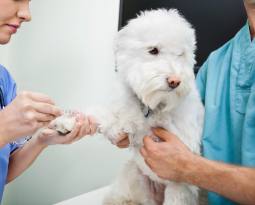Pets can’t tell us when they’re feeling unwell, but changes in their behavior often serve as clues to underlying health issues. From subtle shifts in mood to more obvious signs like aggression or withdrawal, pet behavioral changes can be an indicator that something is amiss. In this blog, we’ll discuss how to recognize behavior problems in pets, when these changes warrant a vet visit, and the role of vet care for behavior issues.
Recognizing Pet Behavioral Changes
Just like humans, pets experience a range of emotions and behaviors. However, a sudden or significant change in how your pet acts can signal a potential health or emotional issue. Some of the most common behavioral changes in pets include:
– Aggression: If your normally friendly pet becomes aggressive, growls, or snaps, it could be due to pain, fear, or another underlying health issue.
– Withdrawal: Pets that suddenly become distant or hide more than usual may be dealing with stress, anxiety, or illness.
– Excessive Barking or Meowing: An increase in vocalization can be your pet’s way of expressing discomfort, anxiety, or boredom.
– Changes in Appetite: A pet that suddenly refuses food or starts overeating may be experiencing digestive problems, pain, or even emotional distress.
– Destructive Behavior: If your pet starts chewing on furniture, scratching excessively, or engaging in other destructive behaviors, it could be a sign of anxiety, frustration, or boredom.
– House Soiling: Pets that have been house-trained but suddenly start having accidents inside the home may be dealing with bladder infections, kidney issues, or stress.
These pet behavioral changes can stem from various causes, ranging from emotional triggers like stress or anxiety to medical problems that require immediate attention.
Common Causes of Pet Behavioral Changes
There are several reasons why pets may display unusual behaviors, and it’s essential to differentiate between minor adjustments and signs that indicate a larger problem. Below are some of the more common causes of pet behavioral changes:
– Pain or Injury: Pets often mask their pain, but behavioral changes like aggression or withdrawal can be signs that they are hurting. For example, a dog that snaps when touched may be suffering from arthritis or an injury.
– Anxiety or Stress: Changes in your pet’s environment, such as moving to a new home, the arrival of a new family member, or even changes in your routine, can cause anxiety. This stress can lead to behaviors like excessive barking, chewing, or pacing.
– Aging: As pets age, they may develop conditions like cognitive dysfunction, which can cause confusion, memory loss, and changes in behavior. An older dog might forget house training, or a cat may become more irritable due to discomfort from arthritis.
– Health Issues: Conditions such as infections, gastrointestinal problems, or even tumors can cause sudden behavioral shifts. For example, a pet with a urinary tract infection might start urinating in unusual places due to discomfort.
When to Visit the Vet for Behavioral Changes
It can be challenging to determine when pet behavioral changes warrant a trip to the vet. Here are some signs that should prompt you to seek vet care for behavior issues:
– Sudden or Severe Changes: If your pet suddenly becomes aggressive, withdrawn, or starts acting in a way that is completely out of character, it’s time to consult your veterinarian. Sudden changes often indicate a physical issue that requires immediate attention.
– Persistent Behavior Issues: If your pet has been displaying unusual behavior for more than a few days, a vet visit is necessary. Persistent behavioral changes, such as a consistent lack of appetite, ongoing aggression, or refusal to move, can signal underlying health problems.
– Physical Symptoms Accompanying Behavioral Changes: If your pet’s behavioral changes are accompanied by physical symptoms such as vomiting, diarrhea, limping, or excessive grooming, it’s crucial to schedule a vet visit. This combination of signs could point to a more serious medical condition.
– Senior Pets: Older pets are more prone to developing health issues that affect their behavior. If your senior pet shows signs of confusion, restlessness, or changes in sleep patterns, consult your vet to rule out age-related conditions like cognitive dysfunction.
What to Expect During a Vet Visit for Behavior Issues
When you bring your pet to the vet for behavioral changes, your veterinarian will perform a thorough physical exam to rule out any medical issues. This may include checking for pain, conducting blood tests, or performing X-rays to identify underlying health conditions.
In some cases, if no physical health problems are found, your vet may recommend behavior modification techniques or refer you to a veterinary behaviorist. A veterinary behaviorist is a specialist trained to diagnose and treat behavior issues in pets that are not caused by a medical condition. They can work with you to develop a plan that addresses your pet’s behavioral concerns through positive reinforcement, training, or even medication if necessary.
Preventing Behavioral Issues in Pets
While some pet behavioral changes are inevitable due to aging or health issues, many problems can be prevented with proactive care and attention. Here are a few tips to help prevent behavior problems in pets:
– Provide Mental and Physical Stimulation: Pets, especially dogs, need regular exercise and mental engagement to stay happy and healthy. Boredom is a common cause of destructive behaviors. Interactive toys, puzzle feeders, and regular playtime can help keep your pet’s mind and body active.
– Stick to a Routine: Pets thrive on routine. Try to keep feeding, exercise, and sleep schedules consistent to minimize stress and anxiety.
– Monitor Health Regularly: Regular vet visits can help catch health issues before they escalate into behavioral problems. Routine check-ups allow your vet to monitor your pet’s overall health and catch any potential concerns early.
– Address Anxiety and Fear Early: If your pet shows signs of anxiety, such as trembling, hiding, or excessive barking, address these issues early with training, environmental changes, or calming products to prevent further behavior problems.
Recognizing behavior problems in pets and knowing when to visit the vet is crucial for maintaining your pet’s health and well-being. Pet behavioral changes can indicate a wide range of issues, from emotional stress to serious medical conditions. By being attentive to your pet’s behavior, consulting with your vet, and providing preventive care, you can help ensure that your pet stays happy, healthy, and well-adjusted.
If your pet is displaying unusual behaviors, don’t hesitate to schedule a vet visit. Early intervention can make all the difference in resolving pet health and behavior concerns. Your veterinarian is your best resource when it comes to understanding and addressing pet behavioral changes.






